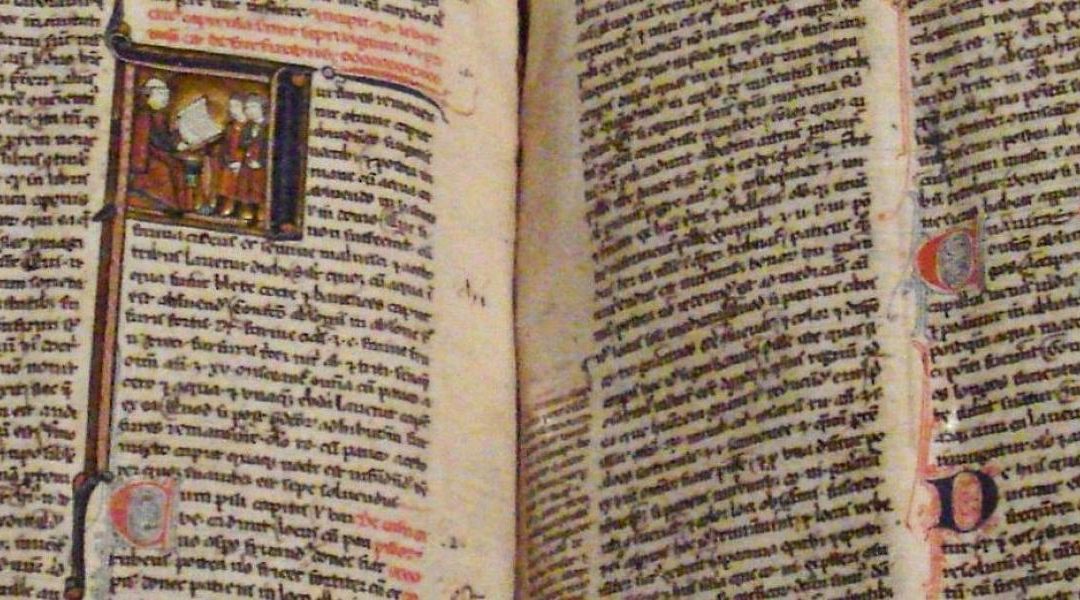—How the Middles Ages took the classical legacy and laid the foundations for the Scientific Revolution.—
We often hear pejorative adjectives inspired by the Middle Ages, such as ‘feudal’ or ‘medieval’. An image of obscurantism still stains this period that lasted ten centuries, in which suffering, pain and death caused by wars, famines and epidemics presided over everything. Furthermore, this image is understood as though nothing had changed between the fifth century, with the fall of the Roman Empire, the eleventh century, with the arrival of feudalism and the encounter with Islam through the crusades, and the fifteenth century, the time of the expansion of the known world with the continent of America and the upheaval caused by the threat of the Turks. Scientific contributions of that time, for the general public and also often for academics who were not specialists in the field, are hardly remarkable, if not non-existent. Moreover, to a large extent, religion is mistakenly considered to be the cause of this ‘backwardness’, with respect to classical Antiquity. This confusion has prevailed since the Renaissance, but when an attempt to overcome it was carried out in the first decades of the twentieth century, it was completely turned around and shifted to seeing the Middle Ages as a dazzling key era, the origin and cause of everything that was achieved later. We must look for the balance between these biased views.
During the process of the dissolution of the Roman Empire, the European West progressively lost contact with the East and the Greek language ended up being forgotten. Western Europe thus lost access to the original treatises of classical philosophers, leaving only some versions of that knowledge that had been translated earlier.
The Western Roman Empire, while united by Latin, still encompassed a large number of different cultures that had been incompletely assimilated by Roman rule. Weakened by the barbaric migrations and invasions and by the political disintegration of Rome in the fifth century, the continent of Europe was a fragmented space after the creation of diverse states within it, which varied greatly in strength and size, and pressured by the expansion of Islam from the seventh century. The European West became a ruralised world, where political instability, the weakness of the State and the decline of urban life deeply affected cultural life. The Church was the only institution that did not disintegrate in that process and was able to maintain ancient knowledge, especially through monasteries. Indeed, it was the regular clergy (monks), and the best trained among the seculars (priests), who devoted themselves to scholarship and to maintaining the knowledge of nature, thanks to copies, commentaries, quotations and compilations. Thus, in this early period of the Early Middle Ages there was hardly any intellectual production.
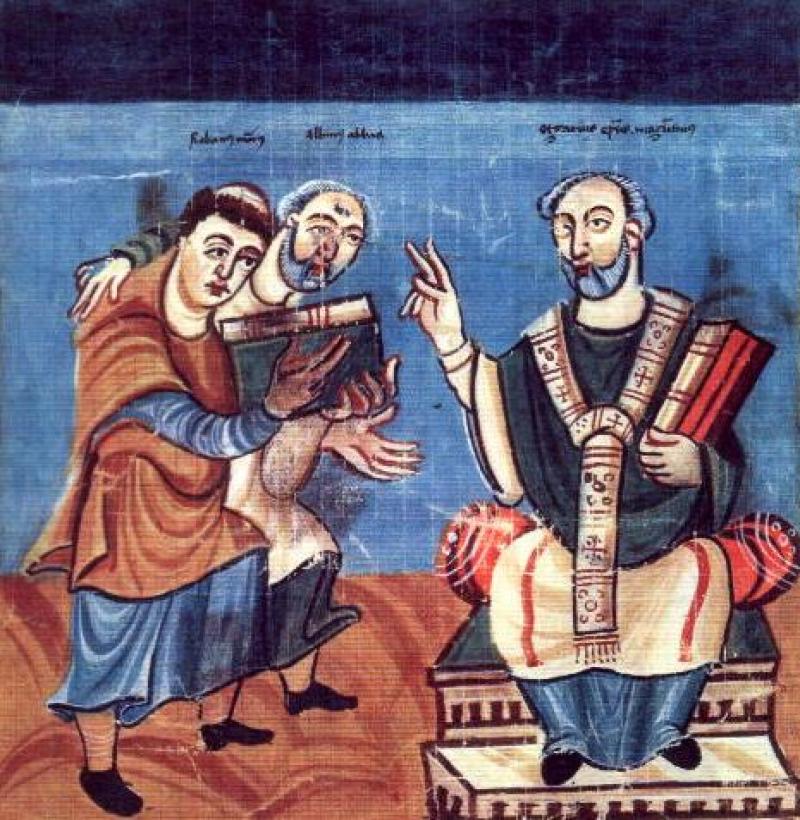
Alcuin of York and Rabanus Maurus. Manuscript from monastery of Fulda, Ósterreichische Nationalbibliothek, Vienna, ca. 836. Wikipedia.
At the end of the eighth century, there was the first attempt at a cultural revival. Charlemagne had managed to reunite much of Europe under his rule. To unify and strengthen his empire, he decided to implement educational reform. The monk Alcuin of York developed a school that sought to reactivate classical knowledge, establishing study programmes from the seven liberal arts, the trivium (grammar, rhetoric, and logic) and the quadrivium (arithmetic, geometry, astronomy, and music). Beginning in 787, a number of decrees were issued recommending the restoration of the old schools and the establishment of new ones. Institutionally, these new schools could be monastic, cathedral and palatine. Only a few centuries later would these measures have their most significant effects.
Approaching the end of the first millennium, medieval society began to undergo profound transformations, coinciding with the end of the invasions. An era of relative tranquillity experienced a period of more benign weather conditions. Thus, around the year 1000 a revolution developed that changed society in all its manifestations: feudalism. A new way of political, economic and social organisation was introduced in Europe and would last until the end of the Middle Ages, having a strong influence even until the end of the Ancien Régime. Technological advances made it possible to cultivate new land and increase the diversity of agricultural products, which sustained a rapidly growing population. Trade recovered remarkably, with the development of land and sea routes, which facilitated not only the exchange of physical goods, but also the exchange of ideas. The cities recovered and grew around castles and monasteries. In this reborn urban environment, where merchants and artisans acquired great prominence, the cathedral and municipal schools would be developed.
The natural philosophers of the late Middle Ages, who we would now call scientists, created an intellectual tradition between the thirteenth and fifteenth centuries without which the path followed during the “Scientific Revolution” would have been impossible. Starting from limited intellectual life in the early medieval centuries, which drew from a crude version of Greek knowledge, it was possible to create a strong culture. A massive translation effort was needed for this, thanks to which the wealth of Greek and Islamic philosophy and science was accessed. It was possible to read and study Aristotle and his Islamic commentators, the medicine of Hippocrates and Galen and the works of many authors on mathematics, astronomy and astrology, alchemy and agronomy, etc.
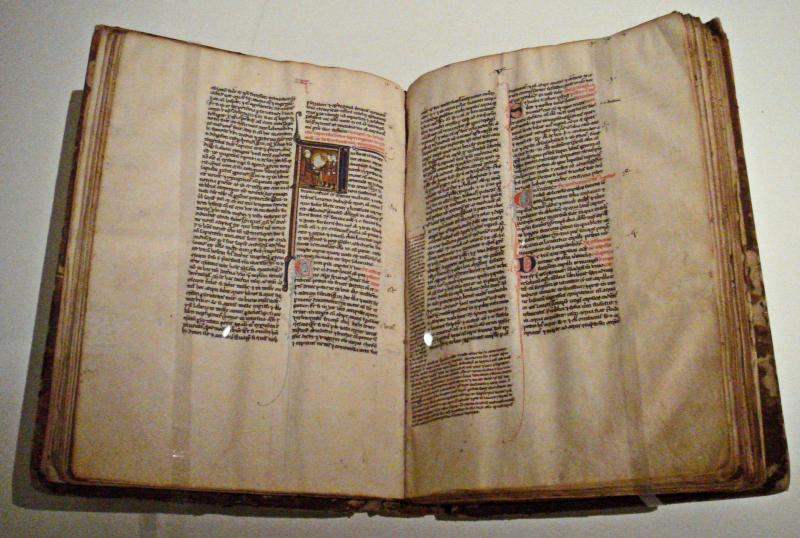
Collection of Treatises on Medicine by the Persian physician Abu-Bakr Muhàmmad ibn Zakariyyà ar-Razí (865-925), translated by Gerard of Cremona, Musee de Cluny, 13th century. Wikipedia.
This body of knowledge was obtained when the West and the East came into contact through the crusades and particularly with the conquest of the Iberian Peninsula, between the eleventh and thirteenth century. In fact, the Islamic world was much more advanced in intellectual and scientific terms. The Arab authors had maintained regular contact with Greek classical works for a long time and had developed translation work in centres such as Baghdad, through a programme of translations from Greek and Syriac into Arabic. This legacy would be fundamental for Western peoples to regain contact with their classical roots. Important translation centres, such as Toledo, Ripoll or the south of Italy (Salerno), were fundamental for this task of translation from Arabic to Latin.
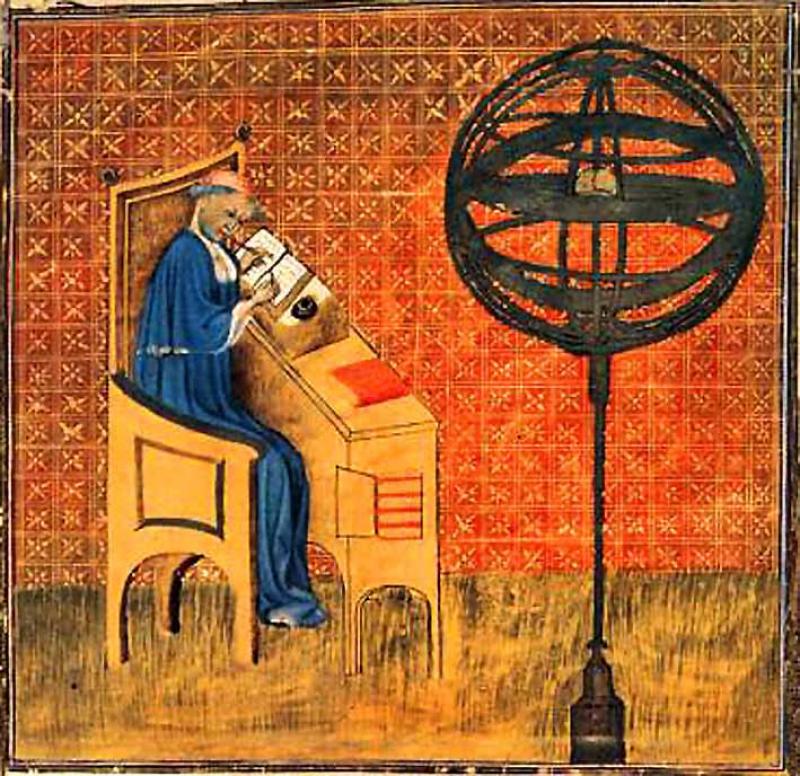
Nicole Oresme, Teatrise of the Sphere, Bibliothèque Nationale de France, Français 565, fol. 1r, Paris. Wikipedia.
Nevertheless, contact with this philosophical content was not limited to its study. The authors who were faced with this diverse corpus of texts were deeply moved by the perspectives they offered. They strove not only to understand its implications, but also to correct its mistakes, resolve its inconsistencies and apply it to new problems. However, it was also necessary to reconcile a pagan or infidel philosophy with Christian doctrine. The great medieval achievement was this synthesis of thought that led to a creative reflection on nature that lasted for centuries.
Medieval natural philosophers subjected Aristotelian philosophy, which they had assimilated combined with other intellectual traditions, to painstaking scrutiny and careful evaluation. This process arose from theological problems but also from the internal tensions of Aristotelian philosophy due to its imprecisions and inconsistencies, in such a way that in the last period of the Middle Ages a total review of Aristotelian theories, such as his description of motion, was sought through the work of authors such as the French clerics Jean Buridan (1300–1358) or Nicolas Oresme (c. 1323–1382). This critical intellectual atmosphere towards the undisputed authority of Aristotle prepared the profound attacks that would come later.
This synthesis of thought which we mentioned found its natural space in the schools and universities founded at that time. The first were formed in Bolonia, Paris and Oxford in the mid-twelfth century but by the end of the Middle Ages there were already more than seventy centres created throughout the Latin West. This was indeed the starting point for the current university model. Some of these institutions received the title of Studium Generale from the Church or monarchs. They were considered the most prestigious places of instruction in Europe and their academics were encouraged to share knowledge and give courses in others of these centres scattered across the continent. Medieval universities were not only educational institutions but also places of research and knowledge production, focal points for vigorous debate and heated controversies.
The natural philosophy studied in the arts faculties was about objective reflection on nature and the universe. It was understood as an essential area of study in itself, as well as a foundation for obtaining other knowledge. It was also an independent and separate field of theology. The classical tradition of natural philosophy became one of the central elements of the curriculum, which was mastered by anyone who wished to take on higher studies. To be cultured meant to be educated in the classical philosophical tradition, including natural philosophy.
Another important factor that influenced the intellectual development of the period was the cultural activity of the preaching orders, especially the Franciscans and Dominicans. Contrary to the monastic orders, turned towards contemplative life in the monasteries, these new orders were dedicated to coexistence with the secular world, and sought to defend the faith through preaching and the use of reason. The integration of such orders into medieval universities provided the necessary infrastructure for the existence of scientific communities and would bear much fruit for the study of nature.
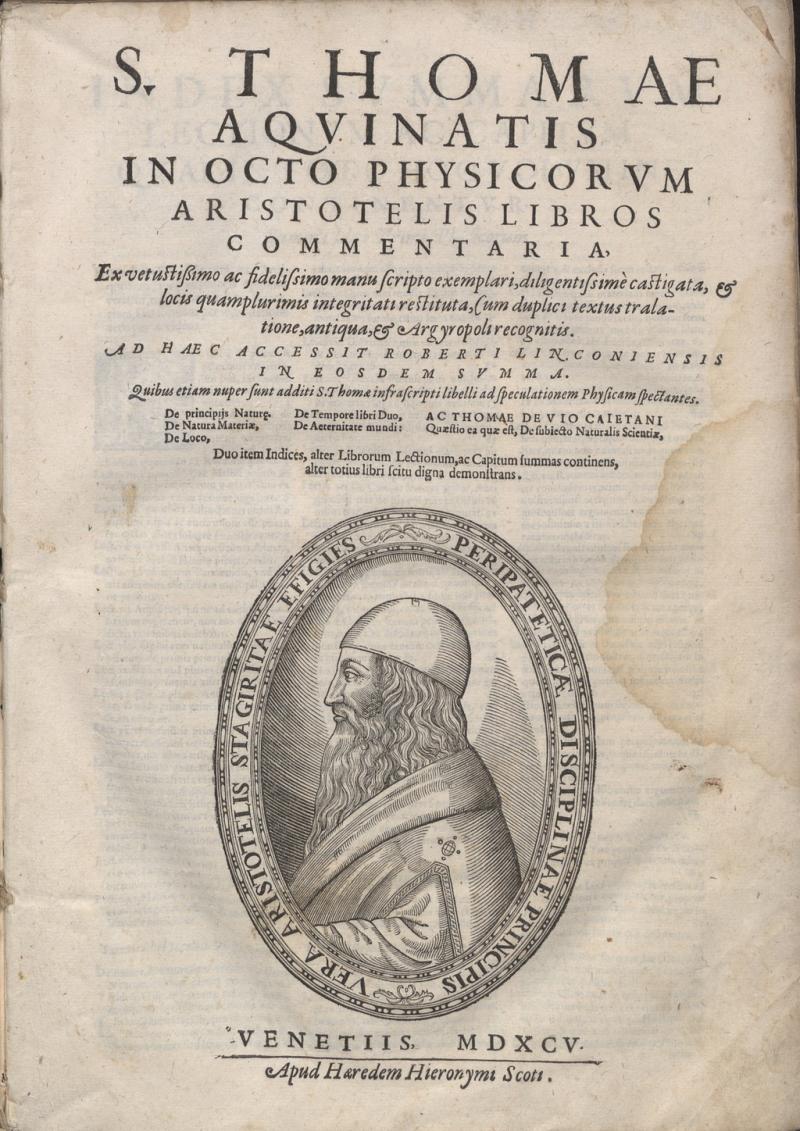
Commentary by Thomas Aquinas on Aristotle’s Physics, printed during the Renaissance, Venice, 1595. Wikipedia.
Dominicans such as Albert the Great (1193–1280) or Thomas Aquinas (1227–1274) exerted an influence on the study of nature that spread among the members of their order and had a great impact on medieval society. The Franciscan Robert Grosseteste (1168-1253), founder of the school of this order at Oxford, was the first scholastic thinker to fully understand the Aristotelian vision of the double path to scientific thought: to generalising from particular observations to a universal law, and then to going in the opposite direction, that is, to deducing predictions for particular situations from universal laws. In addition, he affirmed that these two paths should be verified – or invalidated – through experiments that proved their principles. Grosseteste gave great importance to the study of mathematics as a means of understanding nature and his method of research contained the essential basis for experimental science.
Roger Bacon (1214–1294), a pupil of Grosseteste, paid special attention to the importance of experimentation in increasing the number of known facts about the world. He described a scientific method as a repeated cycle of observation, hypothesis, experimentation and need for verification. Bacon recorded how he carried out his experiments by giving precise details, so that others could replicate his experiments and test the results. The possibility of independent verification is a fundamental part of the contemporary scientific method. Furthermore, the first half of the fourteenth century saw the scientific work of great thinkers. Inspired by Duns Scotus, William of Ockham (1285–1350) understood that philosophy should only deal with subjects about which real knowledge could be obtained.
The fact that the Middle Ages exerted a remarkable influence on the evolution of science is undeniable; numerous elements, such as the analysis of the physical phenomena (for example, kinematics, optics, and astronomy) of the sixteenth and seventeenth century, were but a continuity of the medieval legacy in linguistic, conceptual, and theoretical terms. However, in addition, science and theoretical knowledge was used to improve numerous aspects of medieval society. Medical theories about the development of diseases led to hygiene and public health measures both in cities and in the rural world. With the arsenal of knowledge provided by medical Galenism and the emergence of medical practitioners trained in this paradigm based on natural philosophy, it was possible to understand the functioning of the body and, with this knowledge, to diagnose diseases, make a prognoses and, depending on the case, cure them. Moreover, the physician or surgeon could be an expert voice advising a judge faced with a crime or the authorities in times of epidemics. Many municipalities hired medical personnel to ensure medical care for their residents, believing that this was the best possible option.
Carmel Ferragud
IILP-UV
How to cite this paper:
Ferragud, Carmel. Much more than darkness. Sabers en acció, 2020-11-16. https://sabersenaccio.iec.cat/en/much-more-than-darkness/.
Find out more
You can find further information with the bibliography and available resources.
Recommended reading
González Urbaneja, Pedro M. Matemáticas y matemáticos en el mundo griego. In: Durán Guardeño, Antonio J. El legado de las matemáticas. De Euclides a Newton: los genios a través de sus libros. Seville: Consejería de Cultura (Junta de Andalucía)/Universidad de Sevilla/Real Sociedad Matemática Española; 2000: 23-76.
Lindberg, David C. Los inicios de la ciencia occidental. La tradición científica europea en el contexto filosófico, religioso e institucional (desde el 600 a.C. hasta 1450). Barcelona-Buenos Aires-Mexico: Paidós; 2002, 121-152.
Studies
Boyer, C.B. A History of Mathematics (2nd ed.). New York: Wiley; 1991.
Burton, David M. The history of mathematics. An introduction. Dubuque: Wm. C. Brown Publishers; 1988.
Heath, Thomas. A history of Greek mathematics. Vol. I: From Thales to Euclid. New York: Dover Publications; 1981.
Katz, Victor J. A History of Mathematics: An Introduction (2nd ed.). Addison-Wesley; 1998.
Wussing, H. Lecciones de Historia de las Matemáticas. Madrid: Siglo XXI; 1998.
Websites and other resources
David Calvis. History of mathematics Web Sites. Baldin Wallace College. Ohio. [Accessed 19 June 2020]. Available here.

